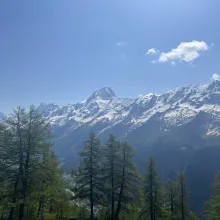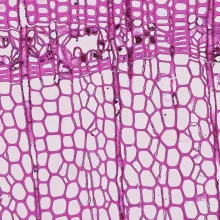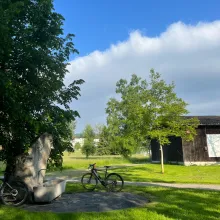The Graduate Interdisciplinary Programs (GIDP) started the Raphael and Jolene Gruener Research Travel Award in 2011. The Grueners have been tireless supporters of interdisciplinary research and education at the University of Arizona. They are also well known for their love of travel. The Gruener Research Travel Award will support awards that fund student research travel, bringing together these two passions of the Grueners.
The award is intended to offset some of the costs associated with international or domestic travel expenses such as airfare, and meals. This is a meritorious award and will be granted on the competitive and innovative content of the statement submitted with the application. Awards are contingent upon the availability of funds. Students are eligible to receive a total of $1,000 per award year. Students may submit only one application per award year during the open application session: mid-February - mid-March.
Julie is a doctoral candidate in the Global Change GIDP Program. For the Gruener Research Travel Award, Julie visited Birmensdorf, Switzerland to conduct their research project titled "High-resolution temperature reconstruction from the North American treeline using quantitative wood anatomy".
Project Summary
Temperatures in the North American Arctic have one of the fastest warming rates on the planet and are projected to increase at more than twice the rate of the global mean over the next century. It is therefore a critical region for observing and understanding climate variability and the simultaneous changes in forests, carbon, ice cover, and extreme events. To better understand how the North American Arctic will change in the future, we must understand how it has changed in the past. However, the short length of instrumental and satellite observations provides limited opportunities for observing past changes in this region.

Fortunately, natural recorders of past climate, such as tree rings, can be used to estimate past temperatures. Each year, a tree grows an annual ring that contains information about the growing environment of that year. For example, tree rings are wider when conditions favor growth and narrower when conditions are unfavorable. Tree-ring data can provide annually resolved climate records that go back centuries to millennia. However, there is a scarcity of long tree-ring records in the North American Arctic. Therefore, our understanding of temperature trends in this region remains severely limited by the striking lack of regional and temperature-sensitive tree-ring data. To address this knowledge gap, we present updated tree-ring data from Firth River, Alaska, to better understand the past climate of this region.
Similar to how tree-ring width can be used to estimate past temperatures, the wood anatomical properties of annual tree rings can also be used to understand past climate. While ring-width data show a limited and unstable association with summer temperatures in this region, wood anatomical properties have been shown to contain a stronger climate signal. We use a novel method called “quantitative wood anatomy” to directly measure wood density and other wood anatomical features, such as cell area size and cell wall thickness. Wood anatomical features can reveal information about climatic conditions during cell growth. Standard tree-ring science techniques have provided a base level of data to understand past climate; however, quantitative wood anatomy techniques can be used to extract more meaningful information.

We find that in high-latitude trees, the maximum cell wall thickness is a strong recorder of August temperature in the North American Arctic, even when using a small number of samples. Our results demonstrate the potential of novel wood anatomical measurements and their ability to fill in data gaps regarding past climate in the North American Arctic.
Post Travel Summary
This summer I was fortunate enough to visit the Swiss Federal Institute for Forest, Snow and Landscape Research (WSL) thanks to the Raphael and Jolene Gruener Research Travel Award. The Dendrosciences group at WSL is one of the most well-known and established research centers for the study of tree rings (dendrochronology). Tree rings provide an invaluable record of past climate from around the world. My research is within a sub-field of dendrochronology known as ‘quantitative wood anatomy’ which uses high-resolution tree-ring thin-section images to measure the characteristics of individual cells in the rings.
The WSL is internationally recognized for its expertise in quantitative wood anatomy, and being able to collaborate with their researchers and learn from their wealth of knowledge was an invaluable experience for the progression of my own research. Interacting with the researchers at WSL allowed me to enhance my laboratory techniques and refine my understanding of this specialized field. The guidance and support I received from everyone in the Dendrosciences group were exceptional, as they patiently walked me through their lab procedures that were not implemented in my home institution, the Laboratory of Tree-Ring Research in Tucson, Arizona.

Due to the limitations imposed by the COVID-19 pandemic, this visit marked the first time I could gain hands-on experience outside of my home institution. Previously, my interactions with the WSL researchers had been limited to email exchanges or Zoom meetings, making this in-person collaboration all the more meaningful. Inspired by their mentorship, I have now taken on the responsibility of training others at my home institution, ensuring that the knowledge and techniques I acquired at WSL can benefit a wider circle of researchers.
I was also able to learn about other data collection methods that relate to the tree-ring and wood anatomy data I use. For the past 16 summers, xylogenesis (wood formation) data has been collected by WSL researchers every week in the Lötschental valley. By tracking the wood formation processes and seasonal timing, we can better understand how tree rings and the cells within rings record past climate. Having come from the arid deserts of Arizona, the opportunity to experience the summer in Switzerland and witness the majestic glaciers was truly remarkable, reigniting my passion for studying climate change.

